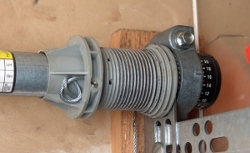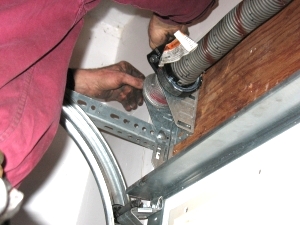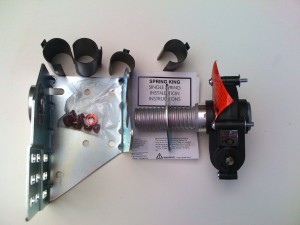Posted June 18th, 2010 at 7:56 pm by Dan Musick
Three main products in the area of garage door spring safety have been introduced in the last 20 years:
Wayne Dalton TorqueMaster springs (shown installed above) wind with a drill. The TorqueMaster is the first system to offer a counter balance spring sealed inside the garage door tube for safety. Because TorqueMaster springs have a smaller mean diameter, they need to be longer to match the lift of a spring. To keep the springs from being too long, however, Wayne Dalton uses a smaller wire size, which leads to problems with cycle life. As a key advantage, if you have two springs on your garage door, there is a winding unit at each end, which makes drill/socket winding a breeze.
Clopay/Ideal EZ-SET springs have their own hardware, winder, and winding cone. Stationary cones can be the standard variety. The shaft has limited room for these. The cycle life on EZ-SET springs somewhat has a limit. However, they have gaps that hold them to the proper length so that the coils will not bind. As a result, these springs appear more slinky-like as compared to standard springs.
Spring King. These winders made by Industrial Spring are no longer available. The Spring King utilizes a drill-winding system for use with standard torsion springs. Therefore, it was a product well-suited for the do-it-yourselfer who would be hesitant to face the task of conventional spring winding.
These three innovations increase safety in the garage door business.
View our first post on garage door springs innovations, or read our next post in this series on extension spring stretching.
This entry was filed under History, How Garage Doors Work. You can follow any responses to this entry through the RSS 2.0 feed.




